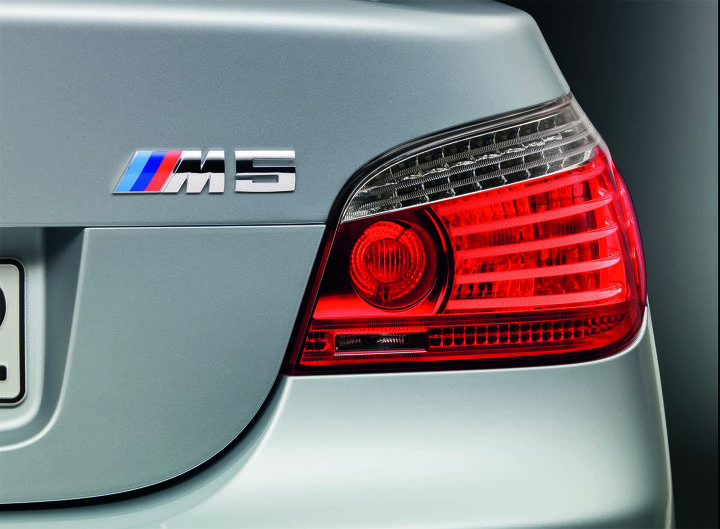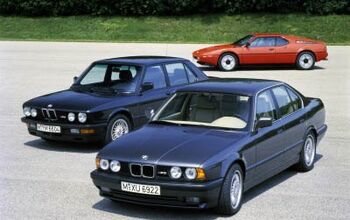40 Years Of The M Series - A Pictorial History. Chapter 1

It was 1972, 40 years ago, when BMW did something that many would later imitate: Much to the chagrin of its own engineers, who were convinced they already had the hottest cars imaginable, and that to touch them meant to desecrate their creations, BMW decided to put the tuners out of business, and created the M series.
Allegedly, the M stood for “Motorsport.”
“A company is like a human being. As long as it goes in for sports, it is fit, well-trained, full of enthusiasm and performance.” With these words, a barely 40 year young whippersnapper by the name of Robert A. Lutz, then responsible for sales at BMW, christened the subsidiary called BMW Motorsport GmbH. Today, it is as old as Bob Lutz was then.
Of course, it was a trick. It wasn’t BMW’s racing team. The M stood for more, for macho, for mammoth motors, for money.
Bob Lutz was one of the new young board members Eberhard von Kuenheim had anointed to help him propel the formerly staid Bavarian maker of motorcycles and Isettas into a future as bright as the high beams with which BMW owners signaled: Make way for the king of the road.
1972 was also same year the new head office was (more or less) finished, the BMW Four-Cylinder building. Today, it would have eight towers. Or maybe six.
1972 seemed like a good year to start a motorsport venture: The Olympics came to Munich, housed not far from the Four Cylinder building. It became an event that many want to forget. Many can’t.
BMW’s former in-house sports department launched the widely successful BMW 1800 TI and 2000 TI. BMW itself was able to meet only a fragment of the overall demand for hot Bimmers, a void tuners were more than happy to fill.
Since the mid-1960s, BMW had been involved in Formula 2. BMW’s racing engines powered many racers to the top of the podium.
The telephone list of the young BMW Motorsport GmbH reads like a hall of fame of car racing. The company was headed by Jochen Neerpasch, the former Porsche works driver who moved to Munich after a stint as Ford’s Racing Manager in Cologne.
His team had names like Chris Amon, Toine Hezemans, Hans-Joachim Stuck and Dieter Quester. Björn Waldegaard and Achim Warmbold were hired as rally drivers.
A year later, a 950-kilo 2002 rolled out of the BMW Motorsport GmbH building at in Preussenstrasse. It had a two-liter four-valve four-cylinder, that made (for the time) exhilarating 240 hp.
Then there was the 3.0 CSL coupé. It hinted at the space-age-material era of the future. The doors and lids were made from aluminum, the five-speed gearbox featured a magnesium housing. Overall weight was 1,092 kg or 2,408 lb. Under the hood lurked a 3,340 cc straight-six with 12 valves, fuel injection and a compression ratio of 11:1. Maximum output: 360 hp. It also was the last two-valve engine that BMW built for racing.
With the 3.0 CSL coupé came a new logo. A complete racing team from car hauler vehicle down to the key tag sported the three blue, violet and red stripes that to this very day tell you that you have been passed by an M-series – if you are quick enough to catch it.
The CSL coupés seemed to be unbeatable. Hans-Joachim Stuck and Chris Amon brought home the Touring Car Grand Prix at the Nürburgring in their very first attempt. BMW was the overall winner of the Touring Car Category in the 24 Hour Race at Le Mans.
The 3.0 CSL became the most successful touring car of its time, dominating the international touring car scene for almost a decade.
The BMW 3.0 CSL pioneered many innovations: It was powered by BMW’s first-ever four-valve six-cylinder. It had a prototype anti-lock braking system, long before it became standard in the BMW 7 Series. At the end of its career, the 3.0 CSL developed maximum output of up to 800 hp.
In 1975, Americans still argued whether BMW stands for “Bavarian Motor Works” or rather “British Motor Works.” BMW Motorsport GmbH wanted to set that straight by focusing on the US IMSA Series. BMW won the Manufacturer’s Category in the IMSA Championship and BMW was a checkered flag on the map.
Well into the second half of the 1970s, BMW Motorsport GmbH focused almost exclusively on the construction of racing cars. This changed when the first “hot” 5 Series came into being from 1974: the 530, 533i, 535i. Initially, they were built and sold in small numbers only, but soon they became popular.
To counteract this trend, the Motorsport GmbH set out to build their first competition car not based on a regular production model: the BMW M1. Lamborghini was supposed to supply the body and the chassis, with BMW supplying the rest. Financial problems at Lamborghini threw the project in disarray. Finally, it looked like there were more companies involved in building the car than cars were initially built.
The spaceframe was manufactured at Marchesi, the glass-fibre reinforced plastic bodyshell was produced at T.I.R., both in Modena. Giorgio Giugiaro’s company ItalDesign assembled them and provided the interiors fittings. The cars were then transported to Stuttgart where Baur installed all the mechanical assemblies.
The minimum production requirement for homologation in FIA Group 4 was 400 units. That made the mid-engined M1 available as a road-going model. It was the first car that sported the soon famous letter “M.”
The price of the 277 hp M1 in 1978 was exactly DM 100,000. This did not dampen the demand. After one year, 130 cars had been completed, and 300 orders were on the books. Right from the start the M1 was the fastest road-going sports car built in Germany. In a test conducted in 1979, the M1 reached a top speed of 264.7 km/h or 164.1 mph. The racing version made 470 hp and reached a top speed well over 300 km/h or 190 mph.
In 1980, a second M-model was built. Starting with a regular 5 Series, the M535i was created, powered by the two-valve six-cylinder from the 635CSi. With an engine output of 218 hp, the car owned the left lane.
In 1984 the fast-revving four-valve straight-six originally featured in the M1 made its appearance in the M635CSi Coupé and in the M5.
The M5 was a genuine “wolf in sheep’s clothing.” In the rear-view mirror, the M5 looked like any other 5-series. When it passed with a top speed of 245 km/h or 152 mph on the Autobahn, it caused dropped jaws. In America, it soon was called “Executive Express.”
1986 the BMW M3 was born. A production run of 5,000 units within one year was needed for homologation in Group A. From the start, it was built as both a race car and a road going car.
In the five years to follow, the M3 was the uncontested leader in the international touring car scene, and it was equally successful as a road-going car, reaching sales volumes nobody would have expected.
Sales of the first BMW M3 amounted to more than 17,970 units, including 600 2.5-litre M3 Sportevolution models as well as 765 M3 convertibles built by hand.
To be continued in Chapter 2.

Bertel Schmitt comes back to journalism after taking a 35 year break in advertising and marketing. He ran and owned advertising agencies in Duesseldorf, Germany, and New York City. Volkswagen A.G. was Bertel's most important corporate account. Schmitt's advertising and marketing career touched many corners of the industry with a special focus on automotive products and services. Since 2004, he lives in Japan and China with his wife <a href="http://www.tomokoandbertel.com"> Tomoko </a>. Bertel Schmitt is a founding board member of the <a href="http://www.offshoresuperseries.com"> Offshore Super Series </a>, an American offshore powerboat racing organization. He is co-owner of the racing team Typhoon.
More by Bertel Schmitt
Latest Car Reviews
Read moreLatest Product Reviews
Read moreRecent Comments
- Haze3 EV median weight is in the range of 4500-5500lbs, similar to the low end of full size pickup trucks and SUV's or typical mid-size PU's and SUV's. Obviously, EV Hummers and PU's are heavier but, on average, EV=PU or mid/full SUV is about right. EV's currently account for ~1% of the cars on the road. PU's account for 17% and SUV's count for over 40%. If we take out light SUV's, then call it 30% SUV or so. So, large-ish PU's and SUV's, together, account for ~50% of the US fleet vs 1% for EV's. As such, the fleet is ALREADY heavy. The problem is that EV's will be making the currently lighter 50% heavier, not that PU/SUV haven't already done most of the damage on avg mass.Sure, the issue is real but EV responsibility is not. If you want to get after heavies, that means getting after PU/SUV's (the current problem by 40-50x) first and foremost.
- Redapple2 Telluride over Acadian (sic-tip cap-canada). 1 better car. 2 60 % us/can content vs 39 THIRTY NINE for an "American" car. 3 no UAW labor. Smart people drive Tellurides. Not so smart for the GMC. Dont support the Evil GM Vampire.!
- Theflyersfan My dad had a 1998 C280 that was rock solid reliable until around 80,000 miles and then it wasn't. Corey might develop a slight right eyelid twitch right about now, but it started with a sunroof that leaked. And the water likely damaged some electric components because soon after the leaks developed, the sunroof stopped working. And then the electrical gremlins took hold. Displays that flickered at times, lights that sometimes decided illumination was for wimps so stayed home, and then the single wiper issue. That thing decided to eat motors. He loved that car but knew when to fold the hand. So he bought a lightly used, off lease E-class. Had that for less than two years before he was ready to leave it in South Philly, keys in the ignition, doors unlocked, and a "Take it please" sign on the windshield. He won't touch another Benz now.
- Detlump A lot of people buy SUVs because they're easier to get in and out of. After decades of longer, lower, wider it was refreshing to have easier ingress/egress offered by an SUV.Ironically, the ease of getting in and out of my Highlander is very similar to my 56 Cadillac.
- Redapple2 LP Michigan. Long straights. A long sweeper. 2 chicanes. 4 hard turns. Lenghts of each element are different but similar to LeMans.






















































Comments
Join the conversation
Wow! Thank you so much for writing this!
A great read, but a depressing one considering the direction the company is going. That legendary tricolor stripes doesn't mean what it used to.